
Project Gutenberg's The Geology of Darling State Park, by Harry W. Dodge, Jr. This eBook is for the use of anyone anywhere in the United States and most other parts of the world at no cost and with almost no restrictions whatsoever. You may copy it, give it away or re-use it under the terms of the Project Gutenberg License included with this eBook or online at www.gutenberg.org. If you are not located in the United States, you'll have to check the laws of the country where you are located before using this ebook. Title: The Geology of Darling State Park Author: Harry W. Dodge, Jr. Release Date: November 19, 2019 [EBook #60730] Language: English Character set encoding: UTF-8 *** START OF THIS PROJECT GUTENBERG EBOOK THE GEOLOGY OF DARLING STATE PARK *** Produced by Stephen Hutcheson, Lisa Corcoran and the Online Distributed Proofreading Team at http://www.pgdp.net

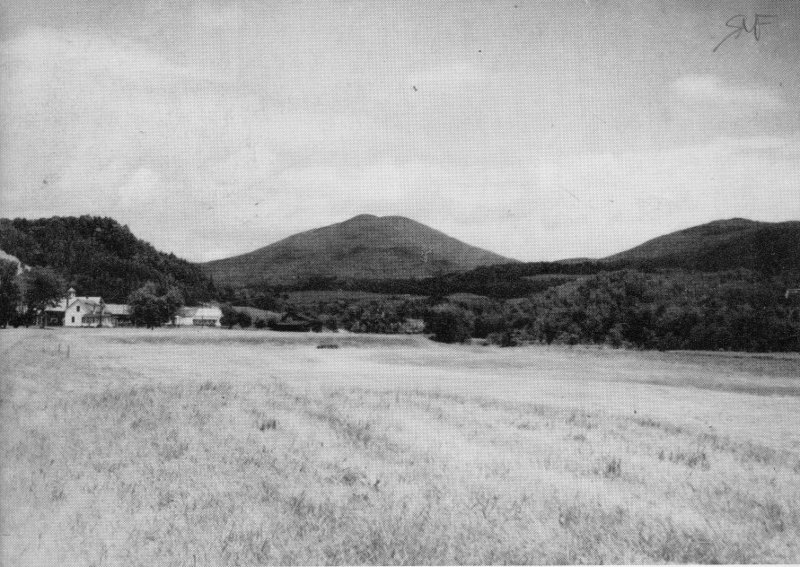
Cover picture: View of Burke Mountain (center, background). Picture taken toward the northeast from State Route 114, about 5 miles south of East Burke.
By
HARRY W. DODGE, JR.
VERMONT GEOLOGICAL SURVEY
Charles G. Doll, State Geologist
DEPARTMENT OF FORESTS AND PARKS
Robert B. Williams, Commissioner
DEPARTMENT OF WATER RESOURCES
1967

Figure 1. Map showing the location of Burke Mountain (Darling State Park), and mountain peaks which can be seen from the summit of Burke Mountain.
| Jay Peak | 39 MILES | 3861′ |
| Gore Mtn. | 25 MILES | 3330′ |
| Monadnock Mtn. | 29 MILES | 3140′ |
| Haystack Mtn. | 35 MILES | 3223′ |
| Belvidere Mtn. | 34 MILES | 3360′ |
| Willoughby Lake | 15 MILES | |
| Bold Mtn. | 15 MILES | 3315′ |
| Mount Mansfield | 44 MILES | 4393′ |
| Stone Mtn. | 11 MILES | 2753′ |
| Mount Washington | 35 MILES | 6288′ |
| Camels Hump | 50 MILES | 4085′ |
| Mount Ascutney | 80 MILES | 3144′ |
By HARRY W. DODGE, JR.
Darling State Park, located in northeastern Vermont (see map, “Burke Mountain,” Fig. 1), offers outstanding opportunities to the camper, picnicker, hiker, view-seeker and winter sportsman. On a clear day the top of Burke Mountain offers a most spectacular view of northeastern Vermont and such distant points as Mount Ascutney (located on the Connecticut River, some 80 miles as the crow flies, to the south). Other prominent peaks that may be seen are Camels Hump (50 miles southwest), Mount Mansfield (44 miles west), Jay Peak (39 miles northwest), and Mount Washington (the highest Peak in the New England States and the northeast, which is located in New Hampshire some 47 miles southeast of Burke Mountain). For the traveler, the view from Burke Mountain reveals “where he has been” and where he might “next go.” See Figure 1 for the location of points which can be seen from the overlooks atop Burke Mountain.
Both the professional and amateur naturalist will find Darling State Park extremely interesting. This pamphlet is devoted primarily to the geology of the park, but the fauna and flora of this area present the visitor with days of interesting studies. It is hoped that in the near future pamphlets describing these aspects of Darling State Park will be published.
Before discussing the more detailed aspects of the geology of Darling State Park, certain basic geologic concepts must be explained. But, even before such a discussion, it might be best to clarify the position of geology among the many other, and oftentimes interrelated, sciences.
The basic reason for the science of geology might be said to be twofold; one is economic, the other related to Man’s basic curiosity. In the first, the geologist through the use of his knowledge of the earth’s rocks, 4 locates those indispensable minerals and fuels without which our advanced society and technology could not exist. In the second, the geologist tries to unlock the many mysteries within the earth’s crust merely to satisfy a thirst for knowledge and to pass such knowledge on to his fellow man. These two basic reasons complement each other and allow continued advancements in geology, both as a pure science and as a primary economic aid to the nation.
As found in most spheres of present-day scientific endeavor, the geologist relies heavily on other related sciences for insight into problems at hand. A basic knowledge, and oftentimes an advanced knowledge, of physics, chemistry, mathematics and zoology, to name only some, are needed before the geologist can approach many of his own problems. It might be obvious to you by now, but a geologist will be certainly included in the first scientific party to journey to the moon and planets.
Within the general science of geology are several branches, to name only a few; paleontology, sedimentology, mineralogy, petrology, stratigraphy, petroleum geology, and structural geology. Each of these branches or specialty-areas contributes basic data for the overall interpretation of the past geologic history of any given geographic area. The historical geologist takes all these clues and attempts to fit the pieces of information together into a picture of past events.
The concept of Geologic Time must be understood before the history of Darling State Park can be unraveled. Usually we think of time in terms of minutes, hours, days, weeks, months and years. The geologist thinks and talks in terms of millions or even billions of years. Time units as short as hundreds of years are impossible to distinguish in the past history of the Earth. When it is realized that the earth is probably 4 to 6 billion (4,000 to 6,000 million) years old, and the record of these years is incomplete, it is easy to understand why the geologist speaks in terms of millions of years instead of years. With modern methods of radioactive dating the geologist hopes for finer time definitions in the future.
In short then, the geologist interprets and puts order into millions of years of history which can only be “read” as recorded in the rocks beneath our very feet. Of course, just looking at the rocks does not magically open the book of geologic history. This pamphlet is designed to sharpen your powers of observation and to help you in your interpretation of these observations.

Figure 2. Thin-section of granite from Burke Mountain. The main minerals seen in this photograph are feldspar (light gray center right, marked with “F”); quartz (whitish, marked with “Q”); biotite (light gray, speckled appearance, marked with “B”). Note the interlocking nature of the minerals which make up this rock. Magnified 15 times, under crossed nicols.
The most conspicuous rock found in the park is granite.[1] Along the road which winds to the summit of Burke Mountain you will see several outcrops of the white or pinkish biotite granite (Fig. 4). This granite is well displayed in the summit parking area and along the trail to the observation tower (Figs. 3 and 5). A walk down the Bear Den Ski Trail also shows an abundance of granite outcrops (Figs. 6, 7, and 8).

Figure 3. Speckled granite with inclusion of metamorphic rock. Black specks in granite are flakes of black biotite mica. Metamorphic inclusion, located just above the hammer head shows some reaction with the invading granite. Pieces of metamorphic rock were undermined by and dropped into the granite as it worked its way upward into these rocks. Picture taken a few yards west of the tower on top of Burke Mt.
While looking at some of the above-mentioned photographs, a second family of rocks is discovered (Figs. 3, 5, 6, 7, and 8; also, Figs. 9, 10, 11, and 16). In many places these rocks have a layered or banded appearance and in other places large lath-like crystals are common in some of the layers. In some areas these rocks are very heterogeneous in appearance and display distorted layers and profuse development of lath-like crystals (Figs. 12 and 13). These rocks belong to the second major family of rocks, the Metamorphic rocks. The metamorphic rocks[2] seen in the park were originally sedimentary[3] rocks. These rocks belong to the Gile Mountain Formation[4] which was deposited during the Devonian Period some 300 million years ago (see Geologic Time Scale[5], Fig. 14). So much for the two major families of rocks present in the park, the igneous and metamorphic rocks, and how to distinguish one from the other. Let us assume that you can now distinguish between the granite and the metamorphic rocks.
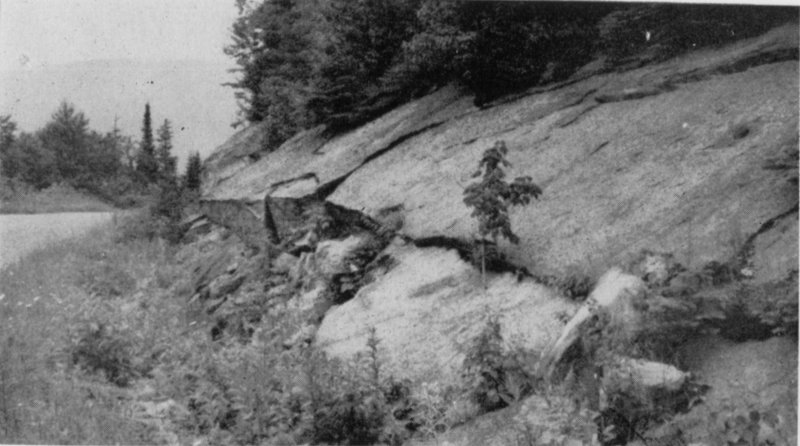
Figure 4. Outcrop of biotite granite located on the summit road between the second and third turns from the summit of Burke Mountain and on the right side of the road if descending. Note the “sheeting structure” or flat joint surface which slopes or dips into the road. This flat break in the rock was probably caused by the release in pressure of the overlying glacial ice when it melted from this region.
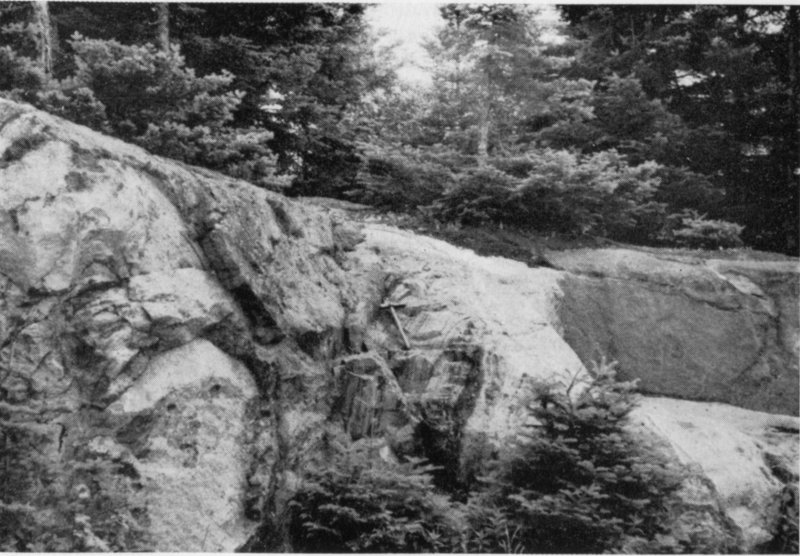
Figure 5. East side of parking area, summit of Burke Mountain. Outcrop of granite with many metamorphic rock inclusions (hammer, center of picture, rests on large inclusion). Layering or banding in the inclusions is almost vertical.

Figure 6. Outcrop located about midway down the Bear Den Ski Trail. Alternating metamorphic quartzite and phyllite invaded by lighter colored and speckled biotite granite. Note how the granite cross-cuts the layered or banded metamorphic rocks. This cross-cutting points out the fact that the layering or banding was present prior to the invasion of the granite.
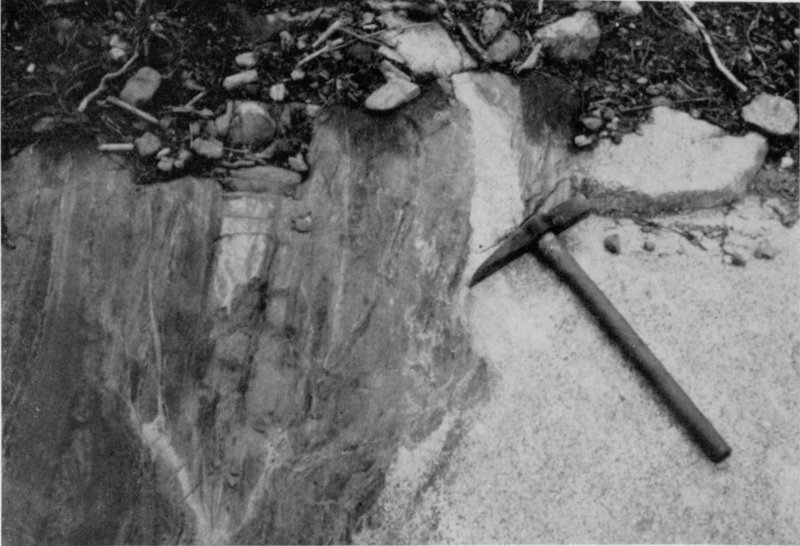
Figure 7. Outcrop located about midway down the Bear Den Ski Trail. Metamorphic quartzite and phyllite (darker color) and invading biotite granite (light speckled appearance). Here the granite has a more or less conformable relationship to the layers or bands in the metamorphic rock. Compare this relationship with the cross-cutting relationship in Fig. 6. For scale, the handle of the geologic hammer or pick is about 12 inches long.
Now, what is the relationship of one to the other? That is, where you can see both of these rock types exposed together in one outcrop, can you describe the physical contact of one with the other? For instance, look at Figure 6, which was taken about midway down the Bear Den Trail, here you see the granite (the white speckled igneous rock which cuts horizontally across the picture) cutting across the distinctly layered or banded metamorphic rocks. The granite is said to have a cross-cutting relationship to the metamorphic rocks. In some outcrops the granite is more or less parallel to the layers of metamorphic rock (Fig. 7). Here, the granite is said to have a conformable relationship with the metamorphic rocks. Still another relationship between the granite and the metamorphic rock is seen in Figure 8. Here, blocks of metamorphic rocks are inclosed by granite. These inclosed blocks are called inclusions and are pieces of invaded rock which fell into or were encircled by the invading granite.

Figure 8. Inclusion of layered or banded metamorphic rock (hammer is resting on this inclusion) in lighter colored biotite granite as seen along the Bear Den Ski Trail. The metamorphic rocks were invaded and undermined by the granitic rocks, with the result that pieces of the metamorphic rock were surrounded by granite. For scale, the handle of the geologic hammer or pick is about 12 inches long.
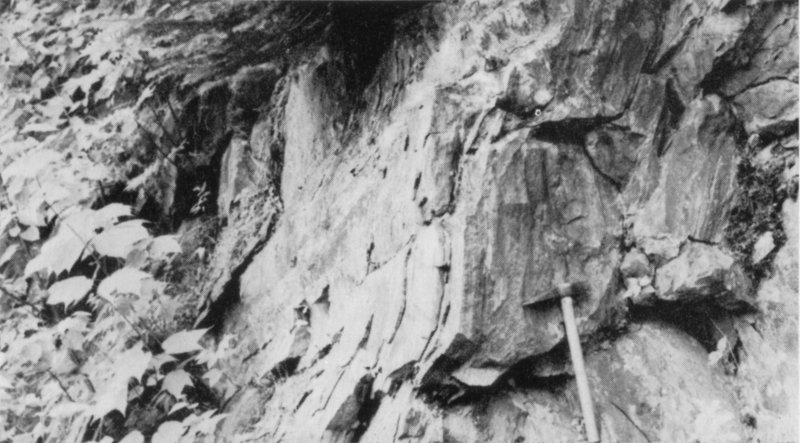
Figure 9. Picture taken along the Burke Mountain summit road of typical Gile Mountain metamorphic rock. Here the rocks dip almost vertically. For those more advanced in geology, note the pillow-like segments or boudinage structure about one foot to the left of the chisel point of the hammer. This structure is due to a stretching of the rock. For scale, the hammer handle is about 12 inches long.
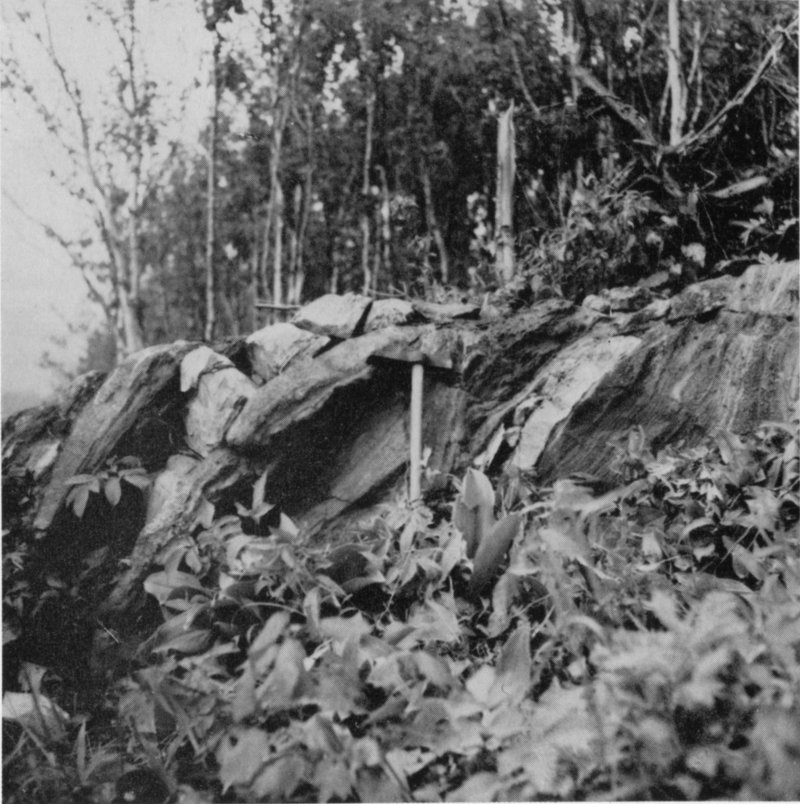
Figure 10. Banded or layered metamorphic rocks with inter-squeezed granite (lighter colored material). This outcrop is located on east side of the Bear Den Ski Trail and quite close to the Burke Mountain summit road. The hammer handle, center of picture, is about one foot long.

Figure 11. Picture taken only a few yards from the Burke Mountain observation tower, along the path to the summit parking lot, looking northwest. Here you see metamorphic rocks (quartzite and phyllite) with some inter-squeezed granite. Note how the nearly vertical metamorphic rock layers bend or “wrap-around” to the right. The highly resistant inter-squeezed granite actually holds Burke Mountain up, or to be more scientific, it prevents these rocks from being worn down as fast as the surrounding rocks. For scale, see the clip board in the center of the picture.
From these relationships, what can be said about the relative ages of the two rock types? Which is the older, or first formed? Which is the last formed? If you study the above relationships for a minute or so, it will become obvious that the layered rock had to be formed prior to the emplacement of the granite. Some of the minerals now seen in the layered or banded metamorphic rocks were formed at the time of granite intrusion, but the basic “stuff” or partially metamorphosed sedimentary rock was present before the granite entered the area from beneath. So, the 13 knowledge of the two rock types present and an understanding of their relationship to one another tells us a story of at least two events which occurred in the park area hundreds of millions of years ago.
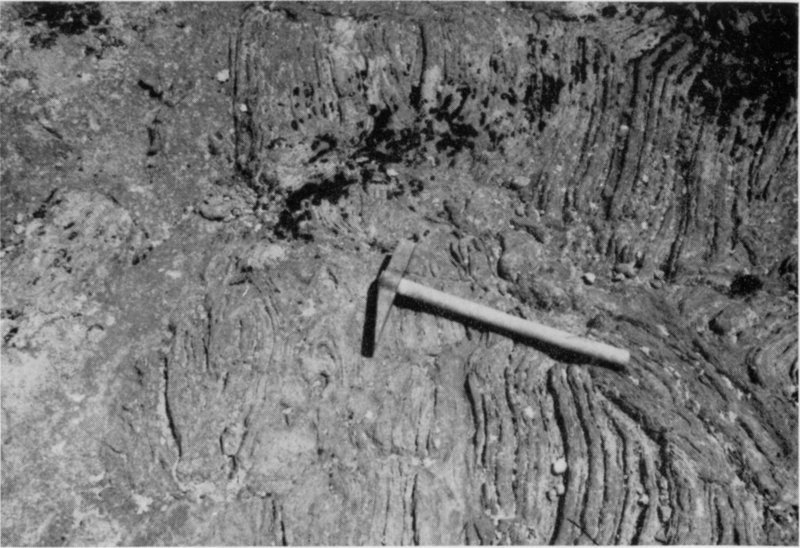
Figure 12. Outcrop on south Lookout, summit of Burke Mountain. Distorted layers of Gile Mountain metamorphic rock. Lath-like crystals developed along some of these layers during the second period of metamorphism, that is, when the granite invaded the metamorphic rocks. For scale, the hammer handle is about one foot long.
Can we find other facts in these rocks which might add to the above-mentioned events? The answer to this question is, yes! The types of minerals found in the metamorphic rocks coupled with the inherited layered structure so common in these rocks, tells us that they were once sedimentary rocks. There is other evidence which indicates that these sedimentary rocks were slightly metamorphosed and folded prior to the invasion of the granite. Added information indicates that these same rocks were subjected to increasing temperatures with the invasion of the granite and another metamorphic mineral change took place. Thus far, the rocks have told us about four distinct events; the deposition and hardening of the Gile Mountain Formation of sedimentary rocks, the first period of wide-spread metamorphism, accompanied by broad folding, the invasion of the granite, and a second phase of metamorphism 14 with the increased temperatures produced by this invasion (see cross-sections illustrating the geologic history of the park area, Fig. 17).

Figure 13. Photograph of the outcrop beneath the observation tower, summit of Burke Mountain. Note the heterogeneous appearance of the granite-infiltrated metamorphic rock. Here the metamorphic rock approaches granite itself in composition and if the process had progressed a bit more, it would be said to be granitized rock. Large lath-like crystals are very prominent in the rocks of this outcrop.
The four events which are mentioned in the preceding paragraph took place hundreds of millions of years ago. What has happened in the park since these events? Take a look at Figure 15, which was taken along the road to the summit of Burke Mountain (coming down from the summit, this outcrop is located on your right, midway between the second and third turns in the road). Here the granite exhibits linear scratches or striations which trend about 40 degrees east of south (general direction in which the hammer handle points). Again, just down the road from the midway picnic and camping area, and on your right, striations can be seen. Here they trend about 45 degrees east of south or approximately in the same direction as the first series of striations mentioned. These scratches or striations occur in many places throughout the park, and in most cases their orientation is about the same. What caused these numerous striations?
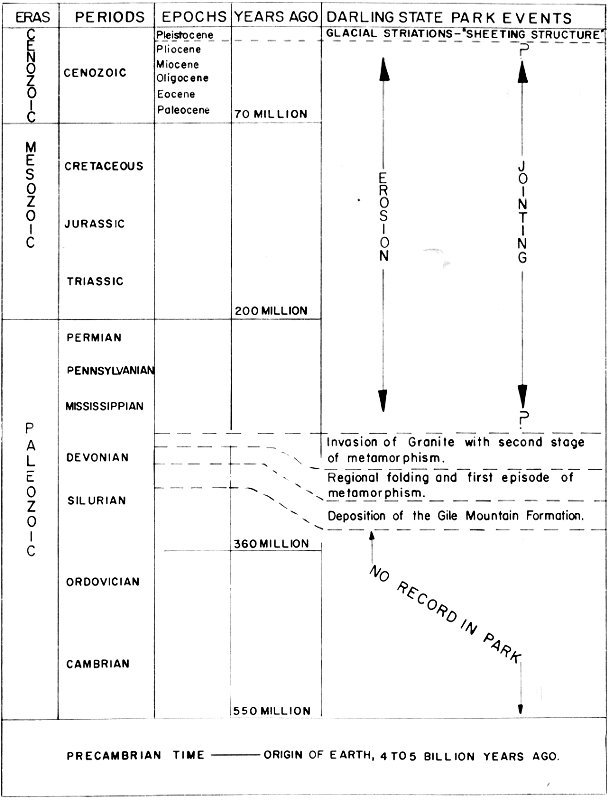
Figure 14. Geologic Time Scale. The main Darling State Park geologic events are noted on the right, opposite the approximate geologic time when each occurred.
| ERAS | PERIODS—YEARS AGO | DARLING STATE PARK EVENTS | ||
|---|---|---|---|---|
| EPOCHS | ||||
| CENOZOIC | CENOZOIC | GLACIAL STRIATIONS—“SHEETING STRUCTURE” | ||
| Pleistocene | ||||
| Pliocene | EROSION, JOINTING | |||
| Miocene | ||||
| Oligocene | ||||
| Eocene | ||||
| Paleocene | ||||
| 70 MILLION | ||||
| MESOZOIC | CRETACEOUS | |||
| JURASSIC | ||||
| TRIASSIC | ||||
| 200 MILLION | ||||
| PALEOZOIC | PERMIAN | |||
| PENNSYLVANIAN | ||||
| MISSISSIPPIAN | EROSION, JOINTING | |||
| Invasion of Granite with second stage of metamorphism. | ||||
| DEVONIAN | Regional folding and first episode of metamorphism. | |||
| SILURIAN | ||||
| Deposition of the Gile Mountain Formation. | ||||
| 360 MILLION | ||||
| NO RECORD IN PARK | ||||
| ORDOVICIAN | ||||
| CAMBRIAN | ||||
| 550 MILLION | ||||
| PRECAMBRIAN TIME——ORIGIN OF EARTH, 4 TO 5 BILLION YEARS AGO. | ||||

Figure 15. Glacial striations or scratches on outcrop midway between the second and third turns in the road down from the summit area of Burke Mountain. Striations trend about 40 degrees east of south or in approximately the same direction that the hammer handle is pointing. Hammer handle is about one foot long.
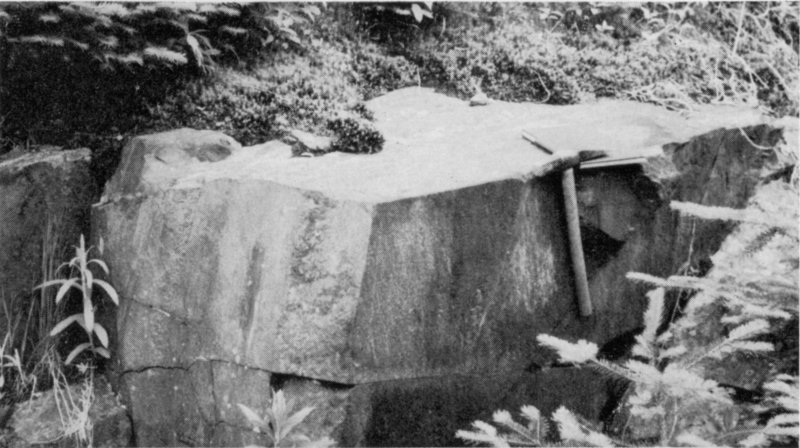
Figure 16. Midway between the second and third turns, descending on the Burke Mountain summit road. Metamorphic quartzite and phyllite showing at least two prominent joints. Layers are vertical and parallel to the front joint (one which hammer handle touches). For the more advanced student of geology, note the lineations parallel to the hammer handle and on the front surface. For scale, hammer handle is about one foot long.
Since they are still preserved in the rocks for us to see, they must have been formed quite recently, that is, geologically speaking. What can explain these striations and their common orientation? Did you ever hear about the Great Ice Age, or the Pleistocene Epoch? Less than one million years ago, in fact, some 12,000 years ago, an ice sheet many thousands of feet thick rode over Burke Mountain in a southeastward direction. The many boulders frozen to the underside of the ice sheet tended to scratch the rocks over which they rode. The scratches or striations seen in the park rocks were caused by these attached boulders. The ice sheet also plucked and rounded Burke Mountain into the shape it possesses today.
A look at Figure 4 shows still another event which occurred during recent geological time. The prominent smooth fracture-surface seen to slope or dip toward the road is called “sheeting structure” which has its origin in post-glacial time. It is thought by many geologists that these flat surfaces or joints[6], which are generally parallel to the ground surface, were formed with the release of the weight of the overlying glacial ice when the glacier retreated northward. So, here we have evidence displayed in the rocks which tells of still another event in the park’s history. It should be mentioned here, while still on the subject of joints, that other joints do occur in the park rocks. Figure 16 shows joints which were formed earlier than the “sheeting” and which are not parallel to the surface of the ground. These joints were probably formed as a result of the removal of the overlying rocks through erosion, thus releasing long-continued pressures produced by the weight of the overlying rocks, and movement of the earth’s crust. We now have the story of two main episodes in the park’s geological history; one took place many millions of years ago, the other within the last 12,000 years. What happened between these two rock-documented episodes?

Figure 17. Geologic cross-sections illustrating the geologic history of Darling State park. (For explanation of cross-sections see top of page 19.)
1. Deposition and hardening of the Gile Mountain Formation. At this stage the layers of rock were more or less horizontal.
2. The horizontal and parallel layers of the Gile Mountain Formation were gently and broadly folded and regionally metamorphosed. This is the first stage of metamorphism in the park area.
3. Invasion by granite. This invasion was accompanied by local metamorphism of the invaded rocks. This is the second stage of metamorphism in the park area. Note the inclusions of first stage metamorphosed Gile Mountain rocks in the granite.
4. Many millions of years of erosion took place, the forces of nature finally exposing the granitic rocks at the surface of the earth.
5. Continued erosion caused the metamorphically reenforced Gile Mountain rocks to wear down more slowly than the surrounding weaker rocks. For this reason, these strengthened rocks stand higher than the weaker rocks.
6. Less than one million years ago the glaciers advanced over the park area. The glacial ice plucked and scratched (striated) the underlying rocks as it slowly advanced southward. During the retreat (northward) certain deposits were left. Present-day Burke Mountain is much the same as it was when the glaciers left, but, some added erosion has taken place and, because of uplift, the Mountain stands a bit higher than it did some 10,000 years ago. Some soil, much of which was removed by the glaciers, has since formed on the mountain.
There are no rocks present in the park which were deposited during this interval of time, therefore, no rock record. If no rocks representing this time interval are present, one of two reasons must be responsible. Either the park area was undergoing active erosion (wearing down) during this period, or sediments were deposited during part or all of this time interval and subsequently completely removed by erosion. Most probably, the intervening time found the park area above the depositional environment of the sea, when its rocks were being worn away by the erosional forces of nature. Again, see Figure 17 for a diagrammatic representation of the geologic history of the park.
Granite is a very resistant rock, that is, it wears away very slowly under the forces of nature. The granite is worn down more slowly than the metamorphic rocks which it has intruded. The granite has been squeezed between and across the layers (bands) of the metamorphic rocks (previously sedimentary rocks) now found on Burke Mountain. In a very true sense, the granite forms a skeleton framework for the metamorphic rocks of Burke Mountain. In other words, it holds these metamorphic rocks up above the surrounding area of metamorphic rocks.
A very interesting hike, both geologically and for nature hunting in general, is the old fire road which begins just above the old C.C.C. camp and the present Bell Gardens. This trail cuts off to the right, if ascending the summit road, and runs completely around the mountain. Shortly after the fire trail intersects the Bear Den Ski Trail, and on the left, granite with obvious drill holes is seen (Fig. 18). Most of the granite used as curb stones, culvert headers, and islands along the park summit road was obtained from these small quarries. A few miles walk along this trail proves quite rewarding to the adventurer; an old lean-to demonstrates what a bear can do while sharpening his claws.
The Devil’s Den Trail leads down the east side of Burke Mountain from the observation tower at the summit. This trail is rather poorly marked past a certain point, but if you wish to strike off on your own and see some wonderful country, a hike down this trail with a swing to the north will bring you back to the summit road.
The several ski trails on Burke Mountain are all walkable during the summer, but they will not appear as smooth as when covered with snow, and the trip down will take considerably longer on foot than on “boards.” The Bear Den Ski Trail is especially good for geological sightseeing.
While at Darling State Park a visit to Lake Willoughby is well worth the trip (Figs. 19, 20). A glance at Figure 1 will show you its general location. Once you visit this lake, you might ask “why so beautiful a Lake Willoughby?” There is still some question as to the origin of the lake basin, but a combination of oriented joints and recent glacial movement seems to fit the picture. Deeper and faster weathering along parallel joints together with glacial movement and scour in the same direction as the joints probably dug the elongated trench which, when filled with water, became Lake Willoughby.
It is hoped that this pamphlet has given you the desire to enlarge your knowledge of the science of geology. Geology is all around you wherever you might travel and a knowledge of geology will open new roads even while traveling old ones. Here’s luck to you in your travels; try to see what you look at.

Figure 18. Geologic map of Darling State Park.

Figure 19. View of Lake Willoughby, seen from its north shore. Mount Pisgah on the left, Mount Hor on the right. The Lake Willoughby trough was produced by preferential erosion of a joint system accentuated by glacial movement and erosion in the same general direction. The lake bottom opposite Mount Pisgah is 210 feet deep.
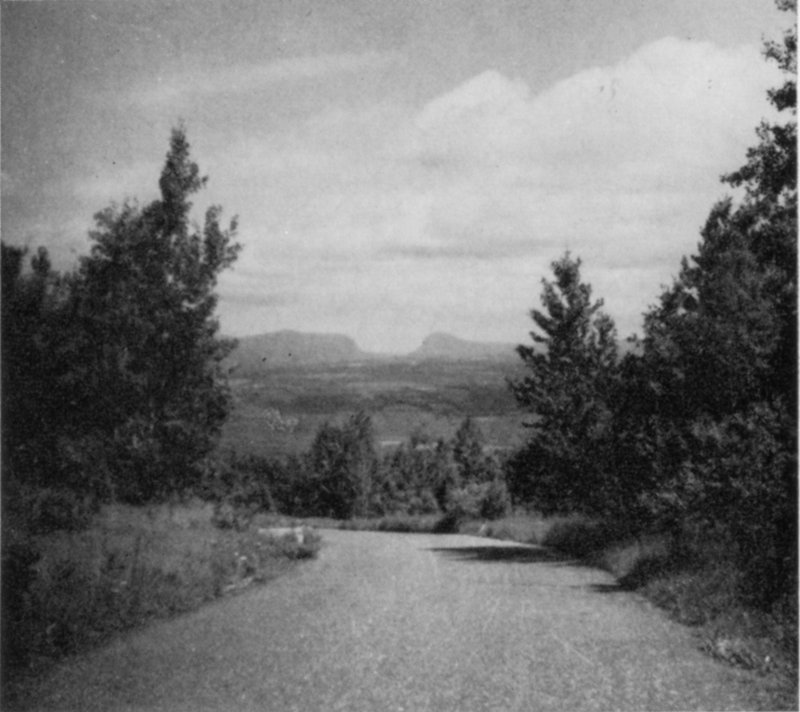
Figure 20. Northwest View from the Burke Mountain summit road. Picture taken just above the old C.C.C. Camp and the present location of the Bell Gardens. Note Lake Willoughby trough in the distance. Mount Pisgah is on the right and Mount Hor on the left. Lake Willoughby lies in this trough.
Leet, L. Don and Judson, S., 1965, Physical Geology, 3rd Edition, Prentice-Hall, Inc., Englewood Cliffs, New Jersey. This is a starter for the geology student.
Dunbar, C. O., 1959, Historical Geology, John Wiley and Sons, New York. Also a beginning book, read after above book.
Dennis, John G., 1956, The Geology of the Lyndonville Area, Vermont, Vermont Geological Survey Bulletin 8. This is for the more advanced student and relates the geology of the area adjacent to Burke Mountain and Darling State Park.
Jacobs, Elbridge C., 1941-42, The Great Ice Age in Vermont, Report of the State Geologist, Vol. 23; pp. 27-47.
Stewart, David P., 1961, The Glacial Geology of Vermont, Vermont Geological Survey, Bulletin No. 19.
Woodland, B. G., 1963, A Petrographic study of Thermally Metamorphosed Pelitic rocks in the Burke Area, Northeastern Vermont, American Journal of Science, volume 261, pages 354-375. For the advanced student.
Woodland, B. G., 1965, The Geology of the Burke Quadrangle, Vermont, Vermont Geological Survey Bulletin No. 28. This is a comprehensive study of the Burke Mountain area and a must for those interested in Darling State Park.
End of the Project Gutenberg EBook of The Geology of Darling State Park, by
Harry W. Dodge, Jr.
*** END OF THIS PROJECT GUTENBERG EBOOK THE GEOLOGY OF DARLING STATE PARK ***
***** This file should be named 60730-h.htm or 60730-h.zip *****
This and all associated files of various formats will be found in:
http://www.gutenberg.org/6/0/7/3/60730/
Produced by Stephen Hutcheson, Lisa Corcoran and the Online
Distributed Proofreading Team at http://www.pgdp.net
Updated editions will replace the previous one--the old editions will
be renamed.
Creating the works from print editions not protected by U.S. copyright
law means that no one owns a United States copyright in these works,
so the Foundation (and you!) can copy and distribute it in the United
States without permission and without paying copyright
royalties. Special rules, set forth in the General Terms of Use part
of this license, apply to copying and distributing Project
Gutenberg-tm electronic works to protect the PROJECT GUTENBERG-tm
concept and trademark. Project Gutenberg is a registered trademark,
and may not be used if you charge for the eBooks, unless you receive
specific permission. If you do not charge anything for copies of this
eBook, complying with the rules is very easy. You may use this eBook
for nearly any purpose such as creation of derivative works, reports,
performances and research. They may be modified and printed and given
away--you may do practically ANYTHING in the United States with eBooks
not protected by U.S. copyright law. Redistribution is subject to the
trademark license, especially commercial redistribution.
START: FULL LICENSE
THE FULL PROJECT GUTENBERG LICENSE
PLEASE READ THIS BEFORE YOU DISTRIBUTE OR USE THIS WORK
To protect the Project Gutenberg-tm mission of promoting the free
distribution of electronic works, by using or distributing this work
(or any other work associated in any way with the phrase "Project
Gutenberg"), you agree to comply with all the terms of the Full
Project Gutenberg-tm License available with this file or online at
www.gutenberg.org/license.
Section 1. General Terms of Use and Redistributing Project
Gutenberg-tm electronic works
1.A. By reading or using any part of this Project Gutenberg-tm
electronic work, you indicate that you have read, understand, agree to
and accept all the terms of this license and intellectual property
(trademark/copyright) agreement. If you do not agree to abide by all
the terms of this agreement, you must cease using and return or
destroy all copies of Project Gutenberg-tm electronic works in your
possession. If you paid a fee for obtaining a copy of or access to a
Project Gutenberg-tm electronic work and you do not agree to be bound
by the terms of this agreement, you may obtain a refund from the
person or entity to whom you paid the fee as set forth in paragraph
1.E.8.
1.B. "Project Gutenberg" is a registered trademark. It may only be
used on or associated in any way with an electronic work by people who
agree to be bound by the terms of this agreement. There are a few
things that you can do with most Project Gutenberg-tm electronic works
even without complying with the full terms of this agreement. See
paragraph 1.C below. There are a lot of things you can do with Project
Gutenberg-tm electronic works if you follow the terms of this
agreement and help preserve free future access to Project Gutenberg-tm
electronic works. See paragraph 1.E below.
1.C. The Project Gutenberg Literary Archive Foundation ("the
Foundation" or PGLAF), owns a compilation copyright in the collection
of Project Gutenberg-tm electronic works. Nearly all the individual
works in the collection are in the public domain in the United
States. If an individual work is unprotected by copyright law in the
United States and you are located in the United States, we do not
claim a right to prevent you from copying, distributing, performing,
displaying or creating derivative works based on the work as long as
all references to Project Gutenberg are removed. Of course, we hope
that you will support the Project Gutenberg-tm mission of promoting
free access to electronic works by freely sharing Project Gutenberg-tm
works in compliance with the terms of this agreement for keeping the
Project Gutenberg-tm name associated with the work. You can easily
comply with the terms of this agreement by keeping this work in the
same format with its attached full Project Gutenberg-tm License when
you share it without charge with others.
1.D. The copyright laws of the place where you are located also govern
what you can do with this work. Copyright laws in most countries are
in a constant state of change. If you are outside the United States,
check the laws of your country in addition to the terms of this
agreement before downloading, copying, displaying, performing,
distributing or creating derivative works based on this work or any
other Project Gutenberg-tm work. The Foundation makes no
representations concerning the copyright status of any work in any
country outside the United States.
1.E. Unless you have removed all references to Project Gutenberg:
1.E.1. The following sentence, with active links to, or other
immediate access to, the full Project Gutenberg-tm License must appear
prominently whenever any copy of a Project Gutenberg-tm work (any work
on which the phrase "Project Gutenberg" appears, or with which the
phrase "Project Gutenberg" is associated) is accessed, displayed,
performed, viewed, copied or distributed:
This eBook is for the use of anyone anywhere in the United States and
most other parts of the world at no cost and with almost no
restrictions whatsoever. You may copy it, give it away or re-use it
under the terms of the Project Gutenberg License included with this
eBook or online at www.gutenberg.org. If you are not located in the
United States, you'll have to check the laws of the country where you
are located before using this ebook.
1.E.2. If an individual Project Gutenberg-tm electronic work is
derived from texts not protected by U.S. copyright law (does not
contain a notice indicating that it is posted with permission of the
copyright holder), the work can be copied and distributed to anyone in
the United States without paying any fees or charges. If you are
redistributing or providing access to a work with the phrase "Project
Gutenberg" associated with or appearing on the work, you must comply
either with the requirements of paragraphs 1.E.1 through 1.E.7 or
obtain permission for the use of the work and the Project Gutenberg-tm
trademark as set forth in paragraphs 1.E.8 or 1.E.9.
1.E.3. If an individual Project Gutenberg-tm electronic work is posted
with the permission of the copyright holder, your use and distribution
must comply with both paragraphs 1.E.1 through 1.E.7 and any
additional terms imposed by the copyright holder. Additional terms
will be linked to the Project Gutenberg-tm License for all works
posted with the permission of the copyright holder found at the
beginning of this work.
1.E.4. Do not unlink or detach or remove the full Project Gutenberg-tm
License terms from this work, or any files containing a part of this
work or any other work associated with Project Gutenberg-tm.
1.E.5. Do not copy, display, perform, distribute or redistribute this
electronic work, or any part of this electronic work, without
prominently displaying the sentence set forth in paragraph 1.E.1 with
active links or immediate access to the full terms of the Project
Gutenberg-tm License.
1.E.6. You may convert to and distribute this work in any binary,
compressed, marked up, nonproprietary or proprietary form, including
any word processing or hypertext form. However, if you provide access
to or distribute copies of a Project Gutenberg-tm work in a format
other than "Plain Vanilla ASCII" or other format used in the official
version posted on the official Project Gutenberg-tm web site
(www.gutenberg.org), you must, at no additional cost, fee or expense
to the user, provide a copy, a means of exporting a copy, or a means
of obtaining a copy upon request, of the work in its original "Plain
Vanilla ASCII" or other form. Any alternate format must include the
full Project Gutenberg-tm License as specified in paragraph 1.E.1.
1.E.7. Do not charge a fee for access to, viewing, displaying,
performing, copying or distributing any Project Gutenberg-tm works
unless you comply with paragraph 1.E.8 or 1.E.9.
1.E.8. You may charge a reasonable fee for copies of or providing
access to or distributing Project Gutenberg-tm electronic works
provided that
* You pay a royalty fee of 20% of the gross profits you derive from
the use of Project Gutenberg-tm works calculated using the method
you already use to calculate your applicable taxes. The fee is owed
to the owner of the Project Gutenberg-tm trademark, but he has
agreed to donate royalties under this paragraph to the Project
Gutenberg Literary Archive Foundation. Royalty payments must be paid
within 60 days following each date on which you prepare (or are
legally required to prepare) your periodic tax returns. Royalty
payments should be clearly marked as such and sent to the Project
Gutenberg Literary Archive Foundation at the address specified in
Section 4, "Information about donations to the Project Gutenberg
Literary Archive Foundation."
* You provide a full refund of any money paid by a user who notifies
you in writing (or by e-mail) within 30 days of receipt that s/he
does not agree to the terms of the full Project Gutenberg-tm
License. You must require such a user to return or destroy all
copies of the works possessed in a physical medium and discontinue
all use of and all access to other copies of Project Gutenberg-tm
works.
* You provide, in accordance with paragraph 1.F.3, a full refund of
any money paid for a work or a replacement copy, if a defect in the
electronic work is discovered and reported to you within 90 days of
receipt of the work.
* You comply with all other terms of this agreement for free
distribution of Project Gutenberg-tm works.
1.E.9. If you wish to charge a fee or distribute a Project
Gutenberg-tm electronic work or group of works on different terms than
are set forth in this agreement, you must obtain permission in writing
from both the Project Gutenberg Literary Archive Foundation and The
Project Gutenberg Trademark LLC, the owner of the Project Gutenberg-tm
trademark. Contact the Foundation as set forth in Section 3 below.
1.F.
1.F.1. Project Gutenberg volunteers and employees expend considerable
effort to identify, do copyright research on, transcribe and proofread
works not protected by U.S. copyright law in creating the Project
Gutenberg-tm collection. Despite these efforts, Project Gutenberg-tm
electronic works, and the medium on which they may be stored, may
contain "Defects," such as, but not limited to, incomplete, inaccurate
or corrupt data, transcription errors, a copyright or other
intellectual property infringement, a defective or damaged disk or
other medium, a computer virus, or computer codes that damage or
cannot be read by your equipment.
1.F.2. LIMITED WARRANTY, DISCLAIMER OF DAMAGES - Except for the "Right
of Replacement or Refund" described in paragraph 1.F.3, the Project
Gutenberg Literary Archive Foundation, the owner of the Project
Gutenberg-tm trademark, and any other party distributing a Project
Gutenberg-tm electronic work under this agreement, disclaim all
liability to you for damages, costs and expenses, including legal
fees. YOU AGREE THAT YOU HAVE NO REMEDIES FOR NEGLIGENCE, STRICT
LIABILITY, BREACH OF WARRANTY OR BREACH OF CONTRACT EXCEPT THOSE
PROVIDED IN PARAGRAPH 1.F.3. YOU AGREE THAT THE FOUNDATION, THE
TRADEMARK OWNER, AND ANY DISTRIBUTOR UNDER THIS AGREEMENT WILL NOT BE
LIABLE TO YOU FOR ACTUAL, DIRECT, INDIRECT, CONSEQUENTIAL, PUNITIVE OR
INCIDENTAL DAMAGES EVEN IF YOU GIVE NOTICE OF THE POSSIBILITY OF SUCH
DAMAGE.
1.F.3. LIMITED RIGHT OF REPLACEMENT OR REFUND - If you discover a
defect in this electronic work within 90 days of receiving it, you can
receive a refund of the money (if any) you paid for it by sending a
written explanation to the person you received the work from. If you
received the work on a physical medium, you must return the medium
with your written explanation. The person or entity that provided you
with the defective work may elect to provide a replacement copy in
lieu of a refund. If you received the work electronically, the person
or entity providing it to you may choose to give you a second
opportunity to receive the work electronically in lieu of a refund. If
the second copy is also defective, you may demand a refund in writing
without further opportunities to fix the problem.
1.F.4. Except for the limited right of replacement or refund set forth
in paragraph 1.F.3, this work is provided to you 'AS-IS', WITH NO
OTHER WARRANTIES OF ANY KIND, EXPRESS OR IMPLIED, INCLUDING BUT NOT
LIMITED TO WARRANTIES OF MERCHANTABILITY OR FITNESS FOR ANY PURPOSE.
1.F.5. Some states do not allow disclaimers of certain implied
warranties or the exclusion or limitation of certain types of
damages. If any disclaimer or limitation set forth in this agreement
violates the law of the state applicable to this agreement, the
agreement shall be interpreted to make the maximum disclaimer or
limitation permitted by the applicable state law. The invalidity or
unenforceability of any provision of this agreement shall not void the
remaining provisions.
1.F.6. INDEMNITY - You agree to indemnify and hold the Foundation, the
trademark owner, any agent or employee of the Foundation, anyone
providing copies of Project Gutenberg-tm electronic works in
accordance with this agreement, and any volunteers associated with the
production, promotion and distribution of Project Gutenberg-tm
electronic works, harmless from all liability, costs and expenses,
including legal fees, that arise directly or indirectly from any of
the following which you do or cause to occur: (a) distribution of this
or any Project Gutenberg-tm work, (b) alteration, modification, or
additions or deletions to any Project Gutenberg-tm work, and (c) any
Defect you cause.
Section 2. Information about the Mission of Project Gutenberg-tm
Project Gutenberg-tm is synonymous with the free distribution of
electronic works in formats readable by the widest variety of
computers including obsolete, old, middle-aged and new computers. It
exists because of the efforts of hundreds of volunteers and donations
from people in all walks of life.
Volunteers and financial support to provide volunteers with the
assistance they need are critical to reaching Project Gutenberg-tm's
goals and ensuring that the Project Gutenberg-tm collection will
remain freely available for generations to come. In 2001, the Project
Gutenberg Literary Archive Foundation was created to provide a secure
and permanent future for Project Gutenberg-tm and future
generations. To learn more about the Project Gutenberg Literary
Archive Foundation and how your efforts and donations can help, see
Sections 3 and 4 and the Foundation information page at
www.gutenberg.org
Section 3. Information about the Project Gutenberg Literary Archive Foundation
The Project Gutenberg Literary Archive Foundation is a non profit
501(c)(3) educational corporation organized under the laws of the
state of Mississippi and granted tax exempt status by the Internal
Revenue Service. The Foundation's EIN or federal tax identification
number is 64-6221541. Contributions to the Project Gutenberg Literary
Archive Foundation are tax deductible to the full extent permitted by
U.S. federal laws and your state's laws.
The Foundation's principal office is in Fairbanks, Alaska, with the
mailing address: PO Box 750175, Fairbanks, AK 99775, but its
volunteers and employees are scattered throughout numerous
locations. Its business office is located at 809 North 1500 West, Salt
Lake City, UT 84116, (801) 596-1887. Email contact links and up to
date contact information can be found at the Foundation's web site and
official page at www.gutenberg.org/contact
For additional contact information:
Dr. Gregory B. Newby
Chief Executive and Director
[email protected]
Section 4. Information about Donations to the Project Gutenberg
Literary Archive Foundation
Project Gutenberg-tm depends upon and cannot survive without wide
spread public support and donations to carry out its mission of
increasing the number of public domain and licensed works that can be
freely distributed in machine readable form accessible by the widest
array of equipment including outdated equipment. Many small donations
($1 to $5,000) are particularly important to maintaining tax exempt
status with the IRS.
The Foundation is committed to complying with the laws regulating
charities and charitable donations in all 50 states of the United
States. Compliance requirements are not uniform and it takes a
considerable effort, much paperwork and many fees to meet and keep up
with these requirements. We do not solicit donations in locations
where we have not received written confirmation of compliance. To SEND
DONATIONS or determine the status of compliance for any particular
state visit www.gutenberg.org/donate
While we cannot and do not solicit contributions from states where we
have not met the solicitation requirements, we know of no prohibition
against accepting unsolicited donations from donors in such states who
approach us with offers to donate.
International donations are gratefully accepted, but we cannot make
any statements concerning tax treatment of donations received from
outside the United States. U.S. laws alone swamp our small staff.
Please check the Project Gutenberg Web pages for current donation
methods and addresses. Donations are accepted in a number of other
ways including checks, online payments and credit card donations. To
donate, please visit: www.gutenberg.org/donate
Section 5. General Information About Project Gutenberg-tm electronic works.
Professor Michael S. Hart was the originator of the Project
Gutenberg-tm concept of a library of electronic works that could be
freely shared with anyone. For forty years, he produced and
distributed Project Gutenberg-tm eBooks with only a loose network of
volunteer support.
Project Gutenberg-tm eBooks are often created from several printed
editions, all of which are confirmed as not protected by copyright in
the U.S. unless a copyright notice is included. Thus, we do not
necessarily keep eBooks in compliance with any particular paper
edition.
Most people start at our Web site which has the main PG search
facility: www.gutenberg.org
This Web site includes information about Project Gutenberg-tm,
including how to make donations to the Project Gutenberg Literary
Archive Foundation, how to help produce our new eBooks, and how to
subscribe to our email newsletter to hear about new eBooks.